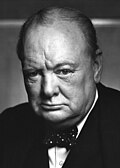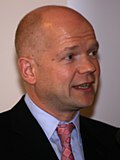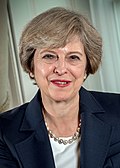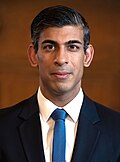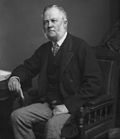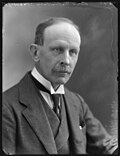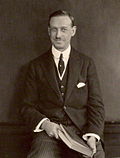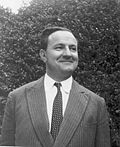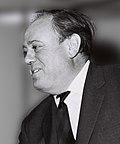Top Qs
Timeline
Chat
Perspective
Leader of the Conservative Party (UK)
Head of the Conservative Party of the United Kingdom From Wikipedia, the free encyclopedia
Remove ads
The leader of the Conservative Party (officially the leader of the Conservative and Unionist Party) is the highest position within the United Kingdom's Conservative Party. The current holder of the position is Kemi Badenoch, whom the party elected on 2 November 2024 when she outpolled Robert Jenrick.[1]
From the party's formation in 1834 until 1922, the leader of the Conservative Party was not a formal position; instead, separate individuals led the party within each chamber of Parliament, and they were considered equal unless one took precedence over the other, such as when one was serving as prime minister. Following the passage of the Parliament Act 1911, the reduction of power in the House of Lords suggested that the Conservative leader in the House of Commons would become preeminent, but this situation was not formalised until 1922.
Since 1922, leaders of the Conservative Party have been formally elected, even when the party is in opposition. Originally, the party leader was appointed opaquely by other high-ranking members of the party. This process was gradually democratised in the late-20th century; in 1965, the appointment was linked to a vote by party MPs, and in 1998, the process was opened to all party members to decide between the top two candidates selected by parliamentarians.[2][3] Under the party's rules, members of the party can vote for a leader even if they are not British citizens, do not reside in the UK, and do not have the right to vote in British elections.[4][5]
When the Conservative Party is in opposition, as is the case as of 2025[update], the leader of the Conservative Party usually acts (as the head of second-largest party) as the Leader of the Opposition, and chairs the shadow cabinet. Concordantly, when the party is in government, the leader usually becomes Prime Minister of the United Kingdom, First Lord of the Treasury, Minister for the Civil Service and Minister for the Union, as well as selecting members of the Cabinet. Four of the party's leaders have been women: Margaret Thatcher, Theresa May, Liz Truss and Kemi Badenoch, all of whom, except Badenoch, have served as prime minister. Rishi Sunak was the first British Indian party leader and prime minister.[6] The only Conservative leaders (excluding temporary acting-leaders) not to contest a general election have been Iain Duncan Smith and Truss (each of whom resigned before the calling of an election).
Remove ads
Selection process
Under the party's constitution,[2] leaders are elected by serving MPs and party members whose membership started at least three months prior to the closing of a ballot. Candidates must be serving MPs. A former leader who has resigned may not stand in the contest triggered by their departure.
Those who wish to stand must notify the 1922 Committee, a body representing backbench Conservative Party MPs, which has broad powers to set the rules of the leadership race (e.g. the minimum number of nominees candidates need).
The party's practice is for MPs to eliminate candidates through multiple rounds of voting until two remain, from whom the winner is then chosen by a ballot of party members.
The 1922 Committee's chairman acts as the returning officer for all stages of the leadership election process.
Remove ads
Overall leaders of the party (1834–1922)
Remove ads
Leaders of the party (1922–present)
Remove ads
Timeline

Houses of Lords and Commons leaders
Summarize
Perspective
This section needs additional citations for verification. (December 2017) |
Leaders in the House of Lords (1834–present)
Those asterisked were considered the overall leader of the party.
- The Duke of Wellington: 1834–1846
- Lord Stanley (14th Earl of Derby from 1851): 9 March 1846 – 27 February 1868*, elected at a party meeting
- The Earl of Malmesbury: 1868–1869, appointed by Prime Minister Disraeli
- The Lord Cairns: 1869–1870, elected at a party meeting
Leaders in the House of Commons (1834–1922)
Those asterisked were considered the overall leader of the party.
- Sir Robert Peel: 18 December 1834[a] – 1846*
- Lord George Bentinck: 1846–1847
- The Marquess of Granby: 9 February 1848 – 4 March 1848, elected at a party meeting
- None: 1848–1849
- Jointly Benjamin Disraeli, the Marquess of Granby, and John Charles Herries: 1849–1852,[d] elected at a party meeting
- Benjamin Disraeli: 1852 – 21 August 1876 (overall leader from 27 February 1868)
- Sir Stafford Northcote: 21 August 1876 – 24 June 1885, appointed by Prime Minister Beaconsfield
- Sir Michael Hicks Beach: 24 June 1885 – 3 August 1886, appointed by Prime Minister Salisbury
- Lord Randolph Churchill: 3 August 1886 – 14 January 1887, appointed by Prime Minister Salisbury
- William Henry Smith: 17 January 1887 – 6 October 1891, appointed by Prime Minister Salisbury
- Arthur Balfour: 1891 – 13 January 1906,[e] appointed by Prime Minister Salisbury (overall leader from 1902)
- Joseph Chamberlain: 1906
- Arthur Balfour: 1906 – 13 November 1911*
- Bonar Law: 13 November 1911 – 21 March 1921, elected at a party meeting (overall leader from 1916)
- Austen Chamberlain: 21 March 1921 – 23 October 1922, elected at a party meeting
Remove ads
Elections of Conservative leaders by party meeting
House of Commons
House of Lords
Remove ads
Deputy Leaders of the Conservative Party
Summarize
Perspective
Deputy Leader of the Conservative Party is sometimes an official title of a senior Conservative politician of the United Kingdom.
Some are given this title officially by the party, such as Peter Lilley,[25] while others are given the title as an unofficial description by the media, such as William Hague.[26] The first politician to hold the office as such was Reginald Maudling, appointed by Edward Heath in 1965.[27] Distinct from being "second-in-command", there is formally no current position of deputy party leader in the party's hierarchy.[28]
The term has sometimes been mistakenly used to refer to the party's deputy chair.[29]
List of deputy leaders
Remove ads
See also
Notes
- Date of the Tamworth Manifesto.
- Date on which Law became Leader of the House of Commons.
- Granby resigned "either in the end of December [1851] or on one of the first days of January [1852]".[8]
- Date on which Balfour failed to be elected in Manchester East.
References
Wikiwand - on
Seamless Wikipedia browsing. On steroids.
Remove ads










